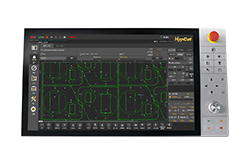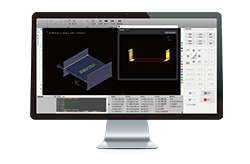-
Products
Overview Products
-
2D Cutting
-
Tube Cutting
-
3D Cutting
-
Intelligent Welding
-
Intelligent Cutting Head
-
Industrial Automation
-
Industrial Software
-
Combination
Controller
-
Combination
BOCHU New Product -
Combination
BOCHU New Product -
Controller
BOCHU New Product -
2D Cutting Head
Tube Cutting Head
3D Cutting Head
Others
BOCHU New Product -
BOCHU New Product
-
- Support
- About
- Online Store

- Software Download
- Manual
- Video
- Tutorial
Ⅰ. Introduction
1. For different sections:
Multiple sections have uneven thickness issues, such as the R corners of H-beams, the flanges of I-beams, and the internal R corners and legs of angle steels and channel steels.
Due to varying thicknesses and working conditions at different positions, it is necessary to differentiate layers to match different process parameters for machining.
Note: Previously, to achieve the effect of Technique Assign, users have to enter Profile Edit and load a "Section Template" to switch layers, such as I-beam rainbow lines. With the introduction of Technique Assign, a significant amount of manual operation can now be avoided.
Ⅱ. How to use
1. Versions and Permissions
| Type | Diagram | Version |
| H Beam |  |
1.57 or higher |
| I Beam |  |
1.59 or higher |
| Angle Steel | 1.61 or higher | |
| Channel Steel | 1.61 or higher | |
| Others |
Only assigned based on the bevel angles |
1.57 or higher |
2. Procedures
Before Export the nesting results, click on Technique Assign. The default parameter can be adopted directly when no special requirements exist.
★ Note: The Technique Assign does not currently take effect on Intersect Hole, if you are using the Intersect Hole , please manually change the Intersect Hole layer according to your actual needs.
Ⅲ. FAQs
1. Where to set the Marking Layer?
On the right layer bar, click on Settings→General Configuration.
2. How to change the default layers?
On the right layer bar, click on Settings→H beam or other types.
For example, to change the layer of the H beam middle web to the 4th layer, all you need to do is to find the Mid Web, and set Layer4.
3. How to identify different angles of bevel?
-
- Step 1: Click on the drop-down menu of Technique Assign and Manage Technique Tag to enter the window for bevel range adjustment.
-
- Step 2: Check the box to enable the bevel range.
-
- Step 3: Adjust the bevel angles for the different techniques assigned.
-
- Step 4: Click OK to save.
Please be aware that the bevel range is applicable for all tube types. In the actual cutting scenarios, the largest bevel angle is 45°.
4. Explain the parameters
Ⅰ. Introduction
1. For different sections:
Multiple sections have uneven thickness issues, such as the R corners of H-beams, the flanges of I-beams, and the internal R corners and legs of angle steels and channel steels.
Due to varying thicknesses and working conditions at different positions, it is necessary to differentiate layers to match different process parameters for machining.
Note: Previously, to achieve the effect of Technique Assign, users have to enter Profile Edit and load a "Section Template" to switch layers, such as I-beam rainbow lines. With the introduction of Technique Assign, a significant amount of manual operation can now be avoided.
Ⅱ. How to use
1. Versions and Permissions
| Type | Diagram | Version |
| H Beam |  |
1.57 or higher |
| I Beam |  |
1.59 or higher |
| Angle Steel | 1.61 or higher | |
| Channel Steel | 1.61 or higher | |
| Others |
Only assigned based on the bevel angles |
1.57 or higher |
2. Procedures
Before Export the nesting results, click on Technique Assign. The default parameter can be adopted directly when no special requirements exist.
★ Note: The Technique Assign does not currently take effect on Intersect Hole, if you are using the Intersect Hole , please manually change the Intersect Hole layer according to your actual needs.
Ⅲ. FAQs
1. Where to set the Marking Layer?
On the right layer bar, click on Settings→General Configuration.
2. How to change the default layers?
On the right layer bar, click on Settings→H beam or other types.
For example, to change the layer of the H beam middle web to the 4th layer, all you need to do is to find the Mid Web, and set Layer4.
3. How to identify different angles of bevel?
-
- Step 1: Click on the drop-down menu of Technique Assign and Manage Technique Tag to enter the window for bevel range adjustment.
-
- Step 2: Check the box to enable the bevel range.
-
- Step 3: Adjust the bevel angles for the different techniques assigned.
-
- Step 4: Click OK to save.
Please be aware that the bevel range is applicable for all tube types. In the actual cutting scenarios, the largest bevel angle is 45°.
4. Explain the parameters





























